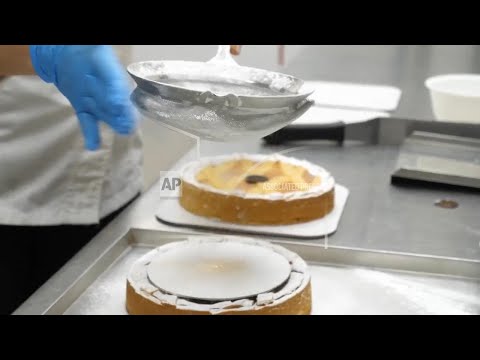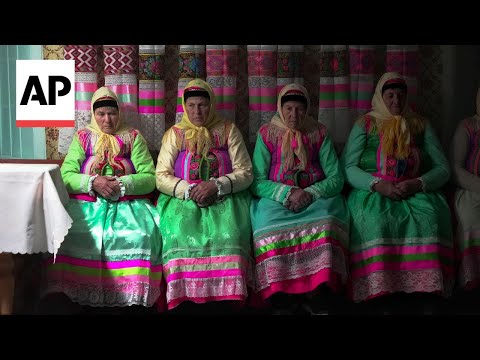(17 Apr 2025)
RESTRICTION SUMMARY:
ASSOCIATED PRESS
Rome, Italy – 16 April 2025
1. Pastry chef and owner of pastry shop Giovanni Colella shaping and rolling out dough for dove-shaped Easter colomba cakes
2. Mid of dove-shaped molds with dough for Easter cakes
3. Close of dough with pieces of candied orange inside
4. Close of Colella placing the dough in the dove-shaped mold
5. Close of chocolate colomba
6. Clients lining in the pastry shop in front of Easter cakes
7. Close of classic colomba cake
8. SOUNDBITE (English) Silvia Stellacci, The Associated Press:
"Every Easter, the kitchens of the Italian pastry shops, like the one I’m in right now, are busy preparing the most iconic and traditional holiday desserts, like the dove-shaped colomba and the fragrant Pastiera Napoletana, which of course comes from the city of Naples. The colomba takes its name from the Italian word for dove, and traditionally represents a symbol of peace and resurrection. Similar in texture to the Christmas panettone, this cake is lighter and is made with a blend of flour, butter, eggs, sugar, vanilla, and candied orange. Its signature finish comes from a generous coating of icing topped with pearl sugar and almonds that give it that a special and delicate crunchy taste. Equally essential is the Pastiera Napoletana, a deeply traditional ricotta pie that combines the creamy ricotta cheese with cooked wheat, orange blossom water, and citrus peels, all of this enclosed in a sweet shortcrust pastry. Both the Pastiera Napolitana and the Colomba are prepared days in advance and are among the best-selling Easter cakes in Italy, together with the more common and widespread chocolate eggs."
9. Traditional Neapolitan ricotta pies being taken out of the oven
10. Various of Marta Boccanera, Gruè pastry shop co-founder, sprinkling powdered sugar
11. Close of chocolate label on the pastiera napoletana
12. Tilt up of chocolate eggs
13. Close of flower decorations on chocolate egg
STORYLINE:
As Easter approaches, Italian pastry shops come alive with the aromas of candied orange peels and fresh-baked dough. It’s the season of two icons of Italian tradition: the Colomba Easter cake and the Pastiera Napoletana pie.
The colomba – Italian word for dove – is called that because of its dove shape and traditionally represents a symbol of peace and resurrection.
Similar in texture to the Christmas panettone, colomba is lighter and made with a blend of flour, butter, eggs, sugar, vanilla, and candied orange.
Another essential part of Italian Easter celebrations is Pastiera Napoletana, a ricotta pie that combines ricotta cheese with cooked wheat, citrus peels, and orange blossoms, all enclosed in a shortcrust pastry.
The origins of pastiera are very ancient and, according to the legend recounted by Boccanera, date back to the nuns of San Gregorio Armeno – a street in Naples – who believed that the orange blossoms used in the cake’s filling symbolised the resurrection of Christ.
In any case, when it comes to eating Easter desserts, 8 out of 10 Italians eat colomba cakes, especially families with children and teenagers, according to a survey by AstraRicerche research institute for the Italian Food Union association.
The total production of Colomba cakes for Easter 2024 was 24,227 tons, equal to 96.7 million euros, with consumption of around 31 million pieces, depending on the same survey.
Even those who generally prefer pastiera pies still buy colomba cakes to celebrate Easter.
AP Video by Paolo Lucariello, Paolo Santalucia
===========================================================
Find out more about AP Archive: http://www.aparchive.com/HowWeWork
Twitter: https://twitter.com/AP_Archive
Facebook: https://www.facebook.com/APArchives
Instagram: https://www.instagram.com/APNews/
You can license this story through AP Archive: http://www.aparchive.com/metadata/youtube/4a06d9a4d482461badf2c9f9b161f008
Author: AP Archive
Go to Source
News post in April 22, 2025, 6:04 am.
Visit Our Sponsor’s:
News Post In – News





